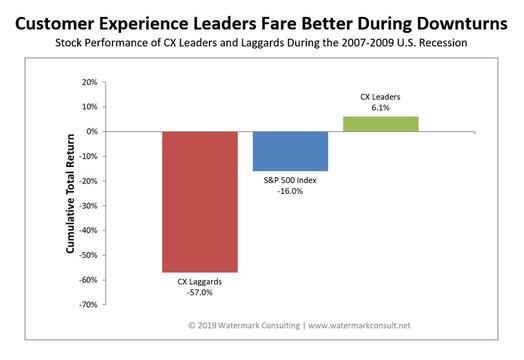|
This customer-centered recession strategy helps companies do more than survive a recession At the beginning of this wonderful year, before a novel virus from the other side of the World created a global pandemic and sudden recession, a prophetic article was published in Forbes. In this Forbes article, the contributor responds to increasing CEO concerns about a looming recession with the “best” business strategy for surviving the new economic climate. With U.S. quarterly growth in Q2 at -33% (annualized), it’s safe to say we are operating in such a recession; so, what is this “best” business strategy? Two letters: CX. Here, we will expound upon the strategy of leading with Customer Experience (CX) during the COVID-19 recession and provide simple tips for kick-starting your initiative into a sustainable program. 1. The most popular recession strategy (and its risks) When a recession comes (especially one as sudden and unpredictable as the present) most business leaders and families take the common sense approach: hold on tight and wait out the storm. This often results in cutting marketing budgets, new launches/initiatives, travel, and eventually...payroll. Cutting costs isn’t innately a bad strategy, but when businesses cut lean muscle along with the fat, long-term success is often robbed to grab short-term gains. Standard recession strategies not only limit businesses in communicating with their customers or launching products (which have shown strong results in recessions) to drive revenue, but can also result in core customer attrition when impacting the customer experience. Choosing between customer satisfaction and lower costs is a false choice - the best performers tighten the belt and reallocate funds to revenue generators (including CX) at the same time. 2. Proof in the pudding: CX Leaders performance during the last recession Referring back to the Forbes article, it cites a customer experience ROI study comparing the cumulative total stock returns during ‘The Great Recession’ of the best and worst-rated CX publicly traded companies. The study showed that top CX organizations significantly outperformed the S&P 500 and actually gained positive stock returns during the official recession period (CX laggards logged -57%). In this recession, will your business be more like USAA and Chic-fil-A or United Airlines and McDonald’s? 3. The CX strategy Companies which focus on CX do so to 1. Increase customer retention, 2. Reduce customer churn (aka attrition), and as a result, 3. Bolster profits. To clarify, customer experience is defined as the impression your customers have of your brand (as a whole) throughout all aspects of the buyer's journey. It results in their view of your brand and impacts factors related to your bottom line including revenue. To be able to survey, monitor, and improve your CX, you’ll need to do the following:
To summarize, the key to boosting the bottom line via CX is two-fold:
4. Getting started Establish the fundamentals - in a report on the special COVID-19 edition of the American Marketing Association’s CMO survey, CX challenges and priorities were measured from the leading marketing executives. Having reviewed the data, the survey directors recommended establishing core fundamentals to capture low-hanging fruit as the first step. These include:
Leverage casual feedback for quick pivots - A simple tactic which is easy to implement is to collect casual customer feedback to make audibles in operations and promotions. The pandemic has thrown consumers, markets, and governments into an unpredictable state, so any rigid plan will falter. Actively listening to casual input through social media reviews, posts, comments, and customer intelligence from employees can give leaders quick feedback for CX tweaks and updates. This data is already coming your way and can be leveraged to improve your CX today (structured within your fundamental mapping of your customers). Capitalize on structured performance indicators for strategic gains - The quick and dirty casual feedback will help with small pivots, but to truly reap the benefits of top customer experience, more structured metrics will need to be established and managed. Having established who your customers are, their buyers journey, and the important touch points, it’s now time to establish a feedback channel for tracking related key performance metrics. Some of the metrics which top companies track include customer satisfaction (CSAT) and customer loyalty (Net Promoter Score). If you establish the management of these CX factors, your customers will give you actionable insights on how to delight them so they keep coming back. 5. Center on CX, compromise elsewhere The simple fact is that all businesses believe themselves to be customer-centered; however, to truly deliver great customer experiences, we need to add a bit of planning and a lot of communication. Consumers are dealing with uncertainty, reduced income, and as a result, many are reducing spending. Small businesses who want to thrive in the COVID economy need to prioritize customer experience to become one of the last line items to get cut by their customers. Companies which prioritize CX have thrived in previous recessions, and this is because their CX leadership was key to driving customer retention. Increasing retention by 5% can lead to profit growth of 25%-95%, so CX needs to be considered as a means to such ends. Business leaders: gather data about your core customers and how they came to become customers, understand what they find most important in their interactions with your business, and utilize both casual and strategic feedback to wade these COVID economic waters to not only survive the storm...but thrive in it. Comments are closed.
|
AuthorWrite something about yourself. No need to be fancy, just an overview. Archives
March 2023
Categories
All
|




 RSS Feed
RSS Feed
